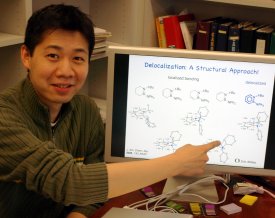Jun 21 2008
Researchers in the lab of University of Oregon chemist Shih-Yuan Liu have successfully synthesized and structurally characterized boron-nitrogen compounds that are isoelectronic and isostructural to the fundamentally important benzene molecule. Given the appearance of benzene derivatives in biomedical research and materials science, the boron-nitrogen substituted analogues could potentially play a pivotal role in these areas.
 Chemist Shih-Yuan Liu points to a graphic depicting his new findings, which could enhance research on new drugs as well as materials.
Chemist Shih-Yuan Liu points to a graphic depicting his new findings, which could enhance research on new drugs as well as materials.
In the Journal of the American Chemical Society, Liu's team reports that, by using a structural approach, benzene surrogates known as 1,2-dihydro-1,2-azaborines possess electron-delocalized structures consistent with aromaticity -- a core concept in chemistry. The paper already has drawn praise by other researchers in a story in this week's Chemical & Engineering News.
"The bottom line is that we have synthesized reference compounds designed to be non-aromatic, and through the comparisons of the aromatic molecule with the reference compounds, we were able to unambiguously say that this compound is really electron delocalized in a way consistent with aromaticity," Liu said. "With the results of other research in this field, our findings present a very strong case that 1,2-dihydro-1,2-azaborines are indeed aromatic."
Liu is among molecule-making chemists who are interested in manipulating heterocycles -- ring-like structures that contain various elements in addition to carbon. Aromatic heterocycles play a big role in pharmaceuticals, Liu said, noting that eight of the top ten selling molecules on the market today contain aromatic compounds.
For biomedical purposes, Liu said, boron-containing molecules disguised with other components readily accepted by living tissues could conceivably be used as markers to track the location of the drug. Eventually, he said, targeted drug therapies might deliver very specific tumor-destroying action that leaves healthy cells untouched.
"Our objective is really to first develop the synthetic chemistry of these boron-nitrogen heterocycles, make it accessible to other chemists to study, and ultimately go into applied research to create opportunities in cancer therapies and materials sciences," Liu said. "I believe that we have made substantial progress for expanding the scope of accessible molecules such as this. The methods we have developed here at the University of Oregon are beginning to be quite useful."
Co-authors on the paper were lead author Eric R. Abbey, a doctoral student, and Lev N. Zakharov, director of the X-Ray Diffraction Lab in the UO's Center for Advanced Materials Characterization in Oregon (CAMCOR). The research was funded in part by the National Science Foundation.